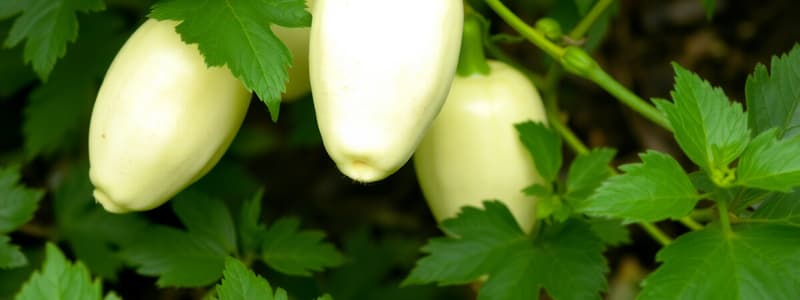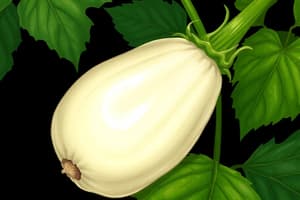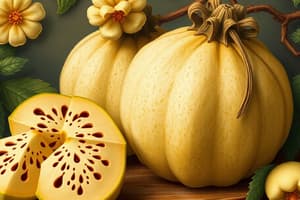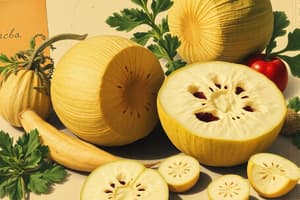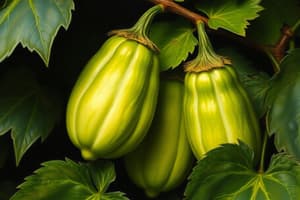Podcast
Questions and Answers
What type of plant is jicama classified as?
What type of plant is jicama classified as?
- Herbaceous vine (correct)
- Annual herb
- Perennial tree
- Woody shrub
Which part of the jicama plant is primarily utilized for consumption?
Which part of the jicama plant is primarily utilized for consumption?
- Flower buds
- Leaves
- Seeds
- Tuberous root (correct)
What is the first step in processing jicama after harvesting?
What is the first step in processing jicama after harvesting?
- Drying in the sun
- Boiling for consumption
- Cutting into slices
- Peeling off the skin (correct)
Where was jicama first domesticated?
Where was jicama first domesticated?
What is the term used to describe jicama's lifespan?
What is the term used to describe jicama's lifespan?
Which family does Jatropha curcas belong to?
Which family does Jatropha curcas belong to?
What is the primary economic purpose for cultivating Jatropha curcas?
What is the primary economic purpose for cultivating Jatropha curcas?
What is the correct order of processing steps for Jatropha seeds after harvesting?
What is the correct order of processing steps for Jatropha seeds after harvesting?
Which of the following is NOT a step involved in processing the oil from Jatropha curcas?
Which of the following is NOT a step involved in processing the oil from Jatropha curcas?
Which part of the Jatropha plant is primarily utilized in oil extraction?
Which part of the Jatropha plant is primarily utilized in oil extraction?
Which family does the myrrh plant belong to?
Which family does the myrrh plant belong to?
What part of the myrrh plant is primarily harvested for commercial use?
What part of the myrrh plant is primarily harvested for commercial use?
What is the first step in the myrrh resin harvesting process?
What is the first step in the myrrh resin harvesting process?
How is the quality of collected myrrh resin assessed?
How is the quality of collected myrrh resin assessed?
What process is used to obtain essential oils from myrrh resin?
What process is used to obtain essential oils from myrrh resin?
Which of the following statements accurately describe true roots?
Which of the following statements accurately describe true roots?
What is a defining characteristic of corms compared to bulbs?
What is a defining characteristic of corms compared to bulbs?
Which of the following is an example of an underground stem classified as a rhizome?
Which of the following is an example of an underground stem classified as a rhizome?
What compound is primarily responsible for the pungent flavor in bulb vegetables from the Allium genus?
What compound is primarily responsible for the pungent flavor in bulb vegetables from the Allium genus?
What type of glycosidic bond links glucose units in starch?
What type of glycosidic bond links glucose units in starch?
Which of the following statements accurately describes cellulose?
Which of the following statements accurately describes cellulose?
What distinguishes bioethanol from gasoline?
What distinguishes bioethanol from gasoline?
Why can most organisms, including humans, not digest cellulose?
Why can most organisms, including humans, not digest cellulose?
What was one of the primary uses of spices in ancient times?
What was one of the primary uses of spices in ancient times?
Which group played a significant role in the spread of spices during the Crusades?
Which group played a significant role in the spread of spices during the Crusades?
What main commodity did Venice trade for exotic spices during the Spice Trade?
What main commodity did Venice trade for exotic spices during the Spice Trade?
Which historical event led to the tragic sacking of Constantinople in 1204?
Which historical event led to the tragic sacking of Constantinople in 1204?
What type of chemical substances are primarily responsible for the flavors and aromas of spices?
What type of chemical substances are primarily responsible for the flavors and aromas of spices?
What is a characteristic of trans fatty acids compared to cis fatty acids?
What is a characteristic of trans fatty acids compared to cis fatty acids?
Which type of plant oil is most associated with being classified as a 'drying oil'?
Which type of plant oil is most associated with being classified as a 'drying oil'?
What is one of the primary risks associated with consuming trans fatty acids?
What is one of the primary risks associated with consuming trans fatty acids?
What is the primary function of latex in plants?
What is the primary function of latex in plants?
What chemical process stabilizes rubber, making it less thermoplastic and more durable?
What chemical process stabilizes rubber, making it less thermoplastic and more durable?
Where is the natural rubber primarily produced today due to the absence of fungal diseases?
Where is the natural rubber primarily produced today due to the absence of fungal diseases?
Which chemical component is added during the vulcanization process to increase the strength of natural rubber?
Which chemical component is added during the vulcanization process to increase the strength of natural rubber?
What structural feature allows the latex to be produced in significant amounts from the Para rubber tree?
What structural feature allows the latex to be produced in significant amounts from the Para rubber tree?
What is the primary purpose of the ginning process in cotton fibre extraction?
What is the primary purpose of the ginning process in cotton fibre extraction?
Which of the following statements correctly describes the use of retting in fibre extraction?
Which of the following statements correctly describes the use of retting in fibre extraction?
Which characteristic of plant fibres is essential in determining their specific uses?
Which characteristic of plant fibres is essential in determining their specific uses?
What is a main feature of the annual varieties of cotton developed by agronomists?
What is a main feature of the annual varieties of cotton developed by agronomists?
Which of the following factors primarily contributes to the genetic uniformity of grape varieties used in winemaking?
Which of the following factors primarily contributes to the genetic uniformity of grape varieties used in winemaking?
What is the main reason red and white wines are produced using different processes?
What is the main reason red and white wines are produced using different processes?
Which of the following pests significantly impacted European grape vines in the mid-1800s?
Which of the following pests significantly impacted European grape vines in the mid-1800s?
What is the role of Saccharomyces ellipsoids in the winemaking process?
What is the role of Saccharomyces ellipsoids in the winemaking process?
Which method is used to extract juice from white wine grapes during production?
Which method is used to extract juice from white wine grapes during production?
Flashcards
What family does Jicama belong to?
What family does Jicama belong to?
Jicama belongs to the Fabaceae family, also known as the legume family. This family includes many other important food crops like beans, peas, lentils, and peanuts.
What type of plant is Jicama?
What type of plant is Jicama?
Jicama is a herbaceous vine, which means it's a non-woody plant with a climbing or trailing growth habit.
Is Jicama a perennial or annual plant?
Is Jicama a perennial or annual plant?
Jicama is a perennial plant, meaning it lives for more than two years. It often goes dormant in the winter and re-emerges in the spring.
Where was Jicama first domesticated?
Where was Jicama first domesticated?
Signup and view all the flashcards
Where is Jicama primarily grown and used?
Where is Jicama primarily grown and used?
Signup and view all the flashcards
What plant family does Jatropha belong to?
What plant family does Jatropha belong to?
Signup and view all the flashcards
What kind of plant is Jatropha?
What kind of plant is Jatropha?
Signup and view all the flashcards
Where is Jatropha native to?
Where is Jatropha native to?
Signup and view all the flashcards
What is Jatropha grown for?
What is Jatropha grown for?
Signup and view all the flashcards
How is oil extracted from Jatropha?
How is oil extracted from Jatropha?
Signup and view all the flashcards
What family does Myrrh belong to?
What family does Myrrh belong to?
Signup and view all the flashcards
What type of plant is Myrrh?
What type of plant is Myrrh?
Signup and view all the flashcards
Where is Myrrh native to?
Where is Myrrh native to?
Signup and view all the flashcards
What part of Myrrh is used commercially?
What part of Myrrh is used commercially?
Signup and view all the flashcards
How is Myrrh resin harvested and processed?
How is Myrrh resin harvested and processed?
Signup and view all the flashcards
Vegetable
Vegetable
Signup and view all the flashcards
Root Crops
Root Crops
Signup and view all the flashcards
Taproots
Taproots
Signup and view all the flashcards
Bulbs
Bulbs
Signup and view all the flashcards
Rhizomes
Rhizomes
Signup and view all the flashcards
What are sugars?
What are sugars?
Signup and view all the flashcards
What is starch?
What is starch?
Signup and view all the flashcards
What is cellulose?
What is cellulose?
Signup and view all the flashcards
What is bioethanol?
What is bioethanol?
Signup and view all the flashcards
What is gasoline?
What is gasoline?
Signup and view all the flashcards
What are spices?
What are spices?
Signup and view all the flashcards
What gives spices their flavor?
What gives spices their flavor?
Signup and view all the flashcards
How did the Crusades impact spices?
How did the Crusades impact spices?
Signup and view all the flashcards
What role did Venice play in the Spice Trade?
What role did Venice play in the Spice Trade?
Signup and view all the flashcards
How did Marco Polo change the spice world?
How did Marco Polo change the spice world?
Signup and view all the flashcards
What are plant oils?
What are plant oils?
Signup and view all the flashcards
What's the difference between saturated and unsaturated fats?
What's the difference between saturated and unsaturated fats?
Signup and view all the flashcards
What is hydrogenation?
What is hydrogenation?
Signup and view all the flashcards
What's the difference between cis and trans double bonds?
What's the difference between cis and trans double bonds?
Signup and view all the flashcards
What are polyunsaturated oils?
What are polyunsaturated oils?
Signup and view all the flashcards
What is Isoprene?
What is Isoprene?
Signup and view all the flashcards
What is Vulcanization?
What is Vulcanization?
Signup and view all the flashcards
Which tree is the main source of natural rubber?
Which tree is the main source of natural rubber?
Signup and view all the flashcards
What is latex?
What is latex?
Signup and view all the flashcards
What is 'crude' rubber?
What is 'crude' rubber?
Signup and view all the flashcards
What are plant fibres?
What are plant fibres?
Signup and view all the flashcards
What is ginning?
What is ginning?
Signup and view all the flashcards
What is retting?
What is retting?
Signup and view all the flashcards
What is decortication?
What is decortication?
Signup and view all the flashcards
What makes cotton so important?
What makes cotton so important?
Signup and view all the flashcards
Retting
Retting
Signup and view all the flashcards
Ginning
Ginning
Signup and view all the flashcards
Wine Fermentation
Wine Fermentation
Signup and view all the flashcards
Red Wine
Red Wine
Signup and view all the flashcards
White Wine
White Wine
Signup and view all the flashcards
Study Notes
Jicama (Pachyrrhizus erosus)
- Botanical Information
- Plant Family: Fabaceae (Pea family)
- Plant Type: Perennial vine
- Native to Mexico and Central America
- History as a Food Plant
- First domesticated in Mexico, by 3000 BC.
- Widely cultivated in Central America, Southeast Asia.
- Introduced to Southeast Asia by the Spanish in the 17th century.
- Utilization
- Part used: Tuberous root
- Processing:
- Harvesting: Roots dug from the ground.
- Peeling: Thin brown skin removed.
- Cutting: Sliced, cubed, or sticks, depending on intended use.
- Enjoying: Eaten raw in salads, salsas, or as a snack with lime juice and chili powder. Cooked in stir-fries, soups, and stews, retaining a crisp texture.
Studying That Suits You
Use AI to generate personalized quizzes and flashcards to suit your learning preferences.
